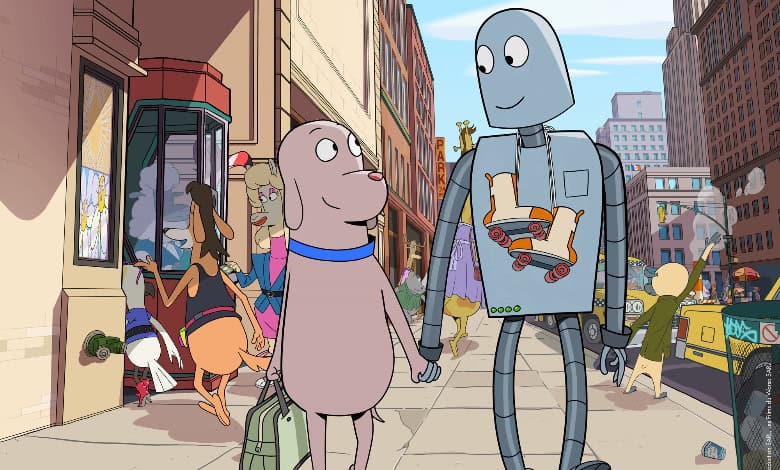
Pablo Berger’s “Robot Dreams” made a name for itself on the festival circuit last year and wound up an Academy Award nominee for Best Animated Feature.
Based on the 2007 comic by Sara Varon, this small but emotionally rich sleeper premiered at the Cannes Film Festival and is finally getting a wide release in theaters.
Set in New York City during the 1980s, “Robot Dreams” presents an animated vision (both hand-drawn and digital techniques presented) of a Big Apple in which everyone is an animal.
Imagine a Ralph Bakshi cartoon minus the explicit vulgarities but not the emotional realism. Or “Zootopia” (2016) minus the cute designs.
We meet Dog, who lives alone, has a nice apartment and spends the evenings watching TV alone. An amusing visual that illustrates this lonely state is how Dog looks out a window, sees a Cow and Moose snuggle in the apartment across the street, making Dog sigh.
Dog watches an ad for the AMICA 2000, offering a robot companion resembling the Tin Man from “The Wizard of Oz.” Dog orders the Robot and the two immediately hit it off. An exhilarating, funny montage, set to Earth Wind & Fire’s “September” illustrates just how magical and real the union between Dog and Robot is…until something unexpected happens.
After a joyous start, “Robot Dreams” becomes an allegory for how hard it is to maintain close friendships, as time, space or other irritating obstacles sometimes get in the way of being with those we miss and think of constantly.
Because this is a period piece, it reminds us of a time when we were at the mercy of pay phones, snail mail and planned meetings that sometimes were missed by not waiting just a few moments longer.
Like myself, you’ll probably think of this movie whenever you hear “September” from now on, as it’s not only the film’s theme but cleverly incorporated into the score in surprising ways.
“Robot Dreams” never references Robot, Dog or any of the characters by gender, and there’s almost no audible dialogue. Rather than come across as a stunt, a political statement or an underlying message, this approach highlights the universal quality of the friendships we witness.
Anyone can look at these characters and connect with them on some level; almost all the characters are anthropomorphized animals and, rather than make them specific types (as “Zootopia” did), we connect to the qualities that make them recognizable, even as the characters are embodied by, for example, a duck (who becomes one of my favorites of Dog’s pals in the second act).
There are three dream sequences, portraying a character’s means of escape and immersion into a new environment – the dandelion tap dance number is especially rapturous to experience on the big screen, as is everything else here.
View this post on Instagram
There are a few sly, funny jokes about the animal world of “Robot Dreams,” such as how Dog is visibly reading “Pet Sematary” at his bedside (if I were to guess, Stephen King is probably a bat or wolf in this world). There’s also a reference to the “Psycho” (1960) shower scene that is funny and non-specific enough that it won’t scare a child, or anyone else.
Aside from a few moments that go for easy laughs, “Robot Dreams” is also unpredictable, with interludes involving a ski trip and another with a family of birds that befriend Robot that are very funny and heartbreaking.
Sometimes you know when Robot is dreaming and can enjoy the flights of escape, while other times we see that Robot is dreaming and wish those explorations were real. If you’re on the fence at this point, I’ll state that the arrival of a character named Rascal the Raccoon is when it all connects.
The ending, as complex as it is, comes like a warm hug.
Bringing a New York Street Scene to Life
The New York Times analyzes a scene with the director from the new animated feature Robot Dreams, based on SVA alumnus Sara Varon’s (MFA 2002 Illustration as Visual Essay) graphic novel of the same name. https://t.co/itmiHoDNXo pic.twitter.com/18GYIZqZsP— School Of Visual Arts (@SVA_News) June 24, 2024
I thought “Robot Dreams” might be too melancholy and slow for little kids the first time I saw it but, if a child has the patience for something like “Wall-E” (2008), a film that has many tonal and thematic similarities), then this is a perfect double feature.
I’m going to come clean about this: I hesitated to write about “Robot Dreams” when I first saw it last year because it devastated me. You read that right. It took me a while to gather my thoughts and revisit “Robot Dreams” recently with my eight-year-old daughter, who found it enjoyable and far less emotionally wrenching than I did.
I won’t spoil the plot or attempt to sway anyone away from seeing this consistently hilarious, deeply felt and emotionally rich experience. I loved it and will watch it again…when I’m alone and can cry my eyes out without anyone wondering what on Earth has gotten into me.
Four Stars

It’s an allegory for homosexuality